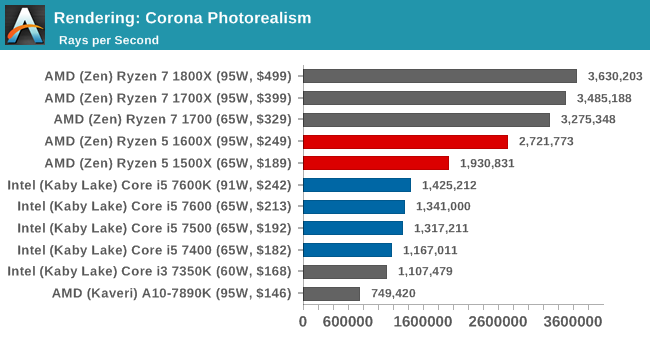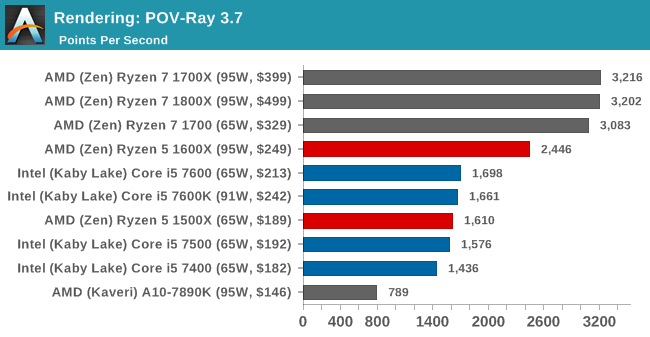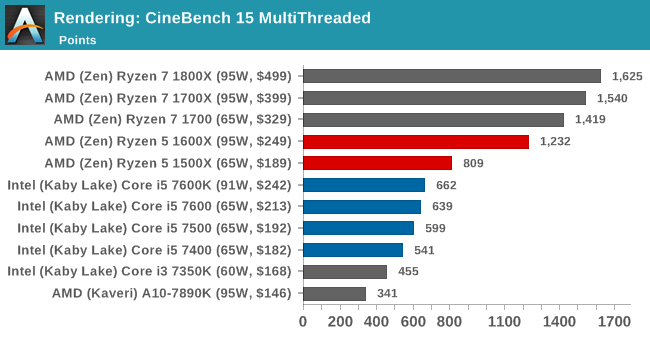The AMD Ryzen 5 1600X vs Core i5 Review: Twelve Threads vs Four at $250
by Ian Cutress on April 11, 2017 9:00 AM ESTBenchmarking Performance: CPU Rendering Tests
Rendering tests are a long-time favorite of reviewers and benchmarkers, as the code used by rendering packages is usually highly optimized to squeeze every little bit of performance out. Sometimes rendering programs end up being heavily memory dependent as well - when you have that many threads flying about with a ton of data, having low latency memory can be key to everything. Here we take a few of the usual rendering packages under Windows 10, as well as a few new interesting benchmarks.
Corona 1.3
Corona is a standalone package designed to assist software like 3ds Max and Maya with photorealism via ray tracing. It's simple - shoot rays, get pixels. OK, it's more complicated than that, but the benchmark renders a fixed scene six times and offers results in terms of time and rays per second. The official benchmark tables list user submitted results in terms of time, however I feel rays per second is a better metric (in general, scores where higher is better seem to be easier to explain anyway). Corona likes to pile on the threads, so the results end up being very staggered based on thread count.
Blender 2.78
For a render that has been around for what seems like ages, Blender is still a highly popular tool. We managed to wrap up a standard workload into the February 5 nightly build of Blender and measure the time it takes to render the first frame of the scene. Being one of the bigger open source tools out there, it means both AMD and Intel work actively to help improve the codebase, for better or for worse on their own/each other's microarchitecture.
POV-Ray 3.7.1
Another regular benchmark in most suites, POV-Ray is another ray-tracer but has been around for many years. It just so happens that during the run up to AMD's Ryzen launch, the code base started to get active again with developers making changes to the code and pushing out updates. Our version and benchmarking started just before that was happening, but given time we will see where the POV-Ray code ends up and adjust in due course.
Cinebench R15
The latest version of CineBench has also become one of those 'used everywhere' benchmarks, particularly as an indicator of single thread performance. High IPC and high frequency gives performance in ST, whereas having good scaling and many cores is where the MT test wins out.















254 Comments
View All Comments
Kamgusta - Tuesday, April 18, 2017 - link
Are you replying to me? I talked about i7-7700 (NOT K), not i7-7700K.Which cope very well with some budget DDR4-2400MHz and a budget H270 board with no penalties whatsoever.
msroadkill612 - Wednesday, May 3, 2017 - link
Interesting. ta for sharing. pretty awesome price for the 1600/mobo bundle.How did the intel mobo compare for functionality do u think?
loguerto - Friday, April 21, 2017 - link
9 is not prime :)LawJikal - Friday, April 21, 2017 - link
What I'm surprised to see missing... in virtually all reviews across the web... is any discussion (by a publication or its readers) on the AM4 platform's longevity and upgradability (in addition to its cost, which is readily discussed).Any Intel Platform - is almost guaranteed to not accommodate a new or significantly revised microarchitecture... beyond the mere "tick". In order to enjoy a "tock", one MUST purchase a new motherboard (if historical precedent is maintained).
AMD AM4 Platform - is almost guaranteed to, AT LEAST, accommodate Ryzen "II" and quite possibly Ryzen "III" processors. And, in such cases, only a new processor and BIOS update will be necessary to do so.
This is not an insignificant point of differentiation.
systemBuilder - Friday, April 28, 2017 - link
I believe the Ryzen core is 20% slower than the Intel core, in instructions per clock. A hyperthread is only about 30% as fast as a full core. With both of these factors thrown in, 6 Ryzen Cores = 5 Intel cores. So the advantage of Ryzen is actually miniscule. It's why I sold all of my AMD stocks in February.willis936 - Thursday, July 27, 2017 - link
"sold all of my AMD stocks in February"I'm cringing.
systemBuilder - Friday, April 28, 2017 - link
Ryzen's cores are 20% slower than Intel's. A hyperthread is only worth (at best) 30% as much as a full core. Therefore, Intel offers 4 cores, AMD offers 6 * 0.8 * 1.3 = 6.24 cores, a decent bump but obviously not significant because few if any games are set up to use more than 8 cores, which in the best case for AMD would be (6 + 0.3 + 0.3)*0.8 = 5.28 cores, a small bump.Cooe - Monday, March 1, 2021 - link
Except Zen 1 was only about ≈5% slower in IPC vs Kaby Lake, not 20%...msroadkill612 - Monday, May 1, 2017 - link
Some thoughts from a ~newb, are that if 8 cores are the new black, then maybe 16GB (or 2GB per core) of ram, isnt as generous as it seems?Also, its a new paradigm. Tasks which taxed the cpu and thus historically avoided (software raid e.g.), can now be embraced with ~impunity.
"Normal" CPUs can handle 16 jobs before a queue forms, commonly, an increase by a factor of 8 for a prospective upgrader.
Gothmoth - Tuesday, May 2, 2017 - link
"...affords a comfortable IPC uplift over Broadwell....."yeah does it?
what is comfortable??.... 10%.... who are you trying to kid here?